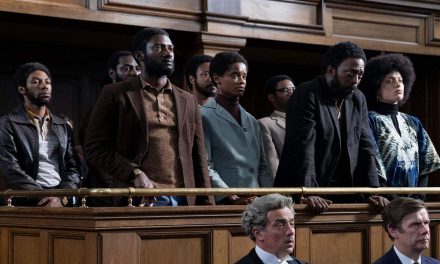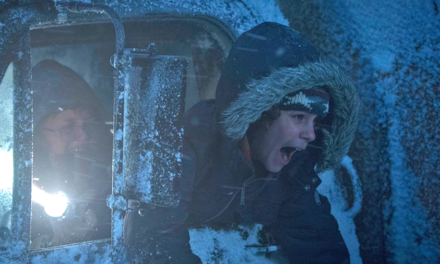No character has quite defined the mystery genre like Sherlock Holmes. Beyond Sir Arthur Conan Doyle’s renowned adventures, the character’s stories have been reimagined countless times. One beloved interpretation is the BBC series Sherlock, a modern interpretation of the character. Like many other fans of the series, I eagerly awaited Sherlock’s fourth season after a three-year hiatus.
This season’s three episodes follow Sherlock Holmes (Benedict Cumberbatch), John Watson (Martin Freeman) and his wife Mary Morstan (Amanda Abbington) immediately after the events of Series 3’s finale “His Last Vow,” which sees Sherlock exiled to eastern Europe, but immediately called back to deal with what appears to be the posthumous endgame of long-time nemesis Jim Moriarty. Sherlock is convinced that the destruction of six identical busts of Margaret Thatcher by aman named Ajay (Sacha Dhiwan) will reveal Moriarty’s true intentions in Season 4’s opener “The Six Thatchers.” Sherlock subsequently uncovers Mary’s and Ajay’s intertwined pasts as disgraced assassins.
“The Six Thatchers” follows the tradition of many previous episodes as the Baker Street crew reenacts Arthur Conan Doyle’s words in modern times amidst loving and humorous references to the series’ source material. Cumberbatch shines as the irreverent and emotionally dysfunctional Sherlock Holmes, interpreting his character in a frantic, almost neurotic fashion. Holmes embraces his modern life, texting during baptisms and top-secret meetings. Insistent on sharing his deductions, with inappropriate or insensitive timing, Cumberbatch nails the excitement Holmes feels from an intriguing mystery. Moreover, viewers will smile as he finally recites the character’s famous, “As ever, Watson, you see but you do not observe” speech and laugh when they recognize he is addressing John and Mary’s infant daughter — who promptly throws a rattle in his face.
It is, however, this feeling of invincibility that drives Moriarty’s temper over the edge and allows her to kill Mary. For the first time, Holmes faces the consequences of his actions in a moment of complete and utter despair.
The following episode, “The Lying Detective,” deals with the first episode’s aftermath and finds its protagonist alone on Baker Street in a drugged stupor. In this episode, actors Freeman and Abbington take center stage as John Watson struggles to cope with the death of his wife, who appears in the episode as a figment of his imagination. Watson’s fury at Sherlock for failing to protect his wife is visceral; his anger flares throughout the episode as Abbington seizes her scenes, depicting the version of her character that John Watson perceives.
The cinematography remains incredibly inventive, as the effects team utilizes a surreal method of portraying Sherlock’s thought processes as he faces down serial killer Culverton Smith (Toby Jones). It’s fascinating to visualize the sleek table of Smith’s high-rise meeting room in the middle of a London street, his drugged victims seated around it, and Smith’s leering face dominating the next shot. It’s equally aesthetically pleasing to watch Sherlock pace around the table, the victims and Smith himself, looking for clues. Moreover, the viewers feel the jolt of a sudden scene change as Sherlock’s mind realizes he has been removed from the street and placed back into his apartment as the walls of 221B Baker Street descend on Sherlock like a projector screen.
The series finale, “The Final Problem,” suffers under the weight of bringing the season to a close. Sherlock, Watson and Mycroft Holmes (Mark Gatiss) face off against the secret Holmes sibling, Eurus Holmes. Through a series of trials, Eurus dissects her long lost brother and his thought processes. The cast does a brilliant job of depicting the emotional stress that accompanies murder and suicide, as the trio faces the constant decision of deciding who to kill and who to spare.
Unfortunately, this final installment suffers from feeling more like a Saw movie than a mystery show. Moreover, it refuses to address the idea of consequences that the first two episodes set up with Mary’s death and its disastrous aftermath. Instead, the friend Sherlock alienated in Eurus’ trials shows up beaming in a happy ending. The destruction of Sherlock’s home is undone in a neat compilation of scenes where the apartment is built and restored to exactly how it was. And Sherlock Holmes and John Watson ascend into legend as they’re supposed to, while Mary Watson addresses her “Baker Street boys” (but really addresses the audience) in her final farewell.
Overall, the highlights of this season are the actors — both Cumberbatch and Freeman shine after four years in their roles and prove their chemistry as costars. Although Abbington has only been around for four episodes, she similarly appears as if she’s always been a part of Sherlock‘s story. Gatiss also provides a touching performance in “The Final Problem,” as it is revealed beneath his character’s callous exterior that he has been looking after his younger brother, Sherlock Holmes, all this time.
The first episode’s Dhiwan viscerally depicts anger and emotional pain from the years of torture his character, Ajay, underwent. Jones remains one of the series’ most terrifying villains through his acting alone, as his maniacal take on Culverton Smith adds menace to the bumbling fool his serial killer character pretends to be. While Andrew Scott’s interpretation of Moriarty will always be welcomed by Sherlock fans, it is a shame to see him as a subordinate of a larger scheme. Sian Brooke is, unfortunately the weakest link as the finale’s villain, and the series’ puppet master Eurus. However, her robotic sociopath of a character remains compelling and unpredictable as the Holmes-without-a-heart and touches viewers in an ending where Eurus is saved, returned to captivity and remains in contact with her long lost family.
Ultimately, this fourth, and potentially final, season of Sherlock ends a long run of satisfying stories with a season of unprecedented twists and turns leading to a rather clichéd ending.
Grade: B-





